Abstract
Immunoglobulin Gs (IgGs) from serial bleeds obtained 1 week to 5 months after infection of rabbits with Treponema pallidum were examined for autologous anti-idiotypic (auto-anti-Id) antibodies. The capacities of IgGs to bind 125I-IgG F(ab')2 anti-T. pallidum prepared from earlier bleeds were determined by using radioimmunoassays. Results obtained in these assays suggested that auto-anti-Id IgGs were demonstrable between 60 and 180 days postinfection. Following reinfection, 90 days after the initial infection, auto-anti-Id IgGs peaked 6 to 8 weeks later, even though they were first noted as early as 2 weeks postreinfection. In the reinfection model the auto-anti-Id continued to persist throughout the remaining 3 months of the study. As auto-anti-Id antibodies to anti-fibronectin antibodies were demonstrable also in reinfected animals, our findings raise questions concerning the possible role of the anti-Id in modulating the Id expression of both T. pallidum-specific and autoimmune humoral responses.
Full text
PDF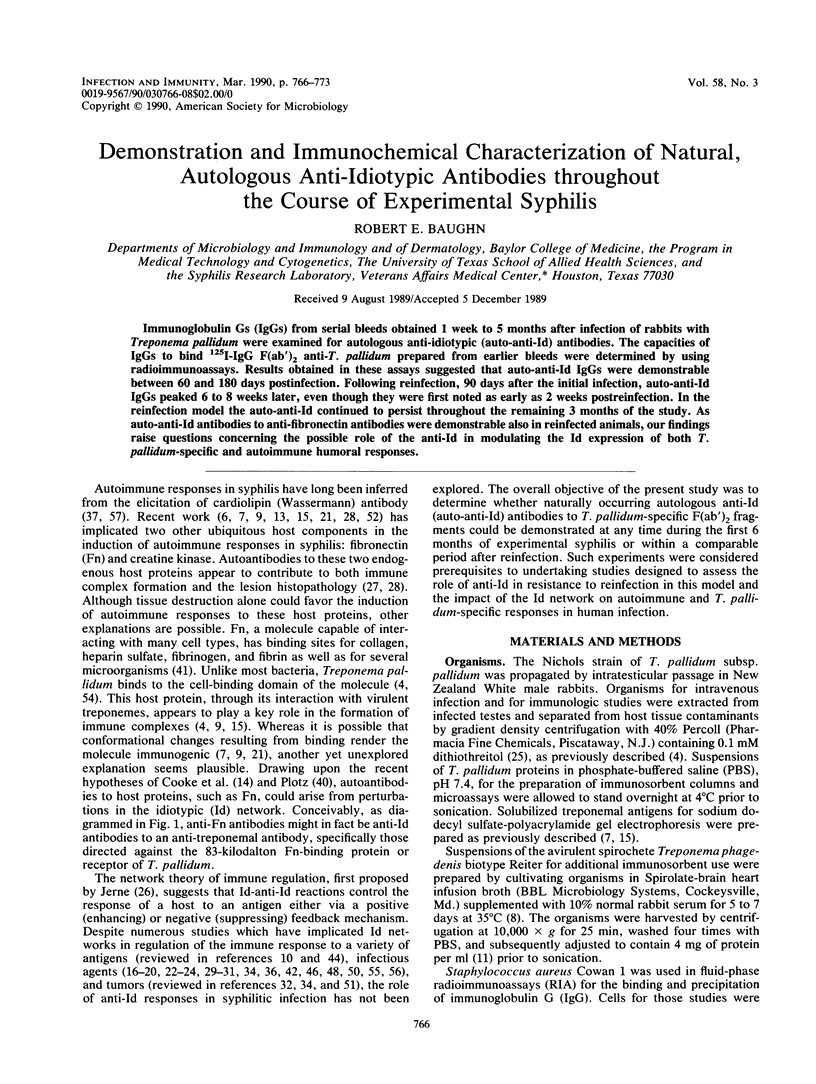
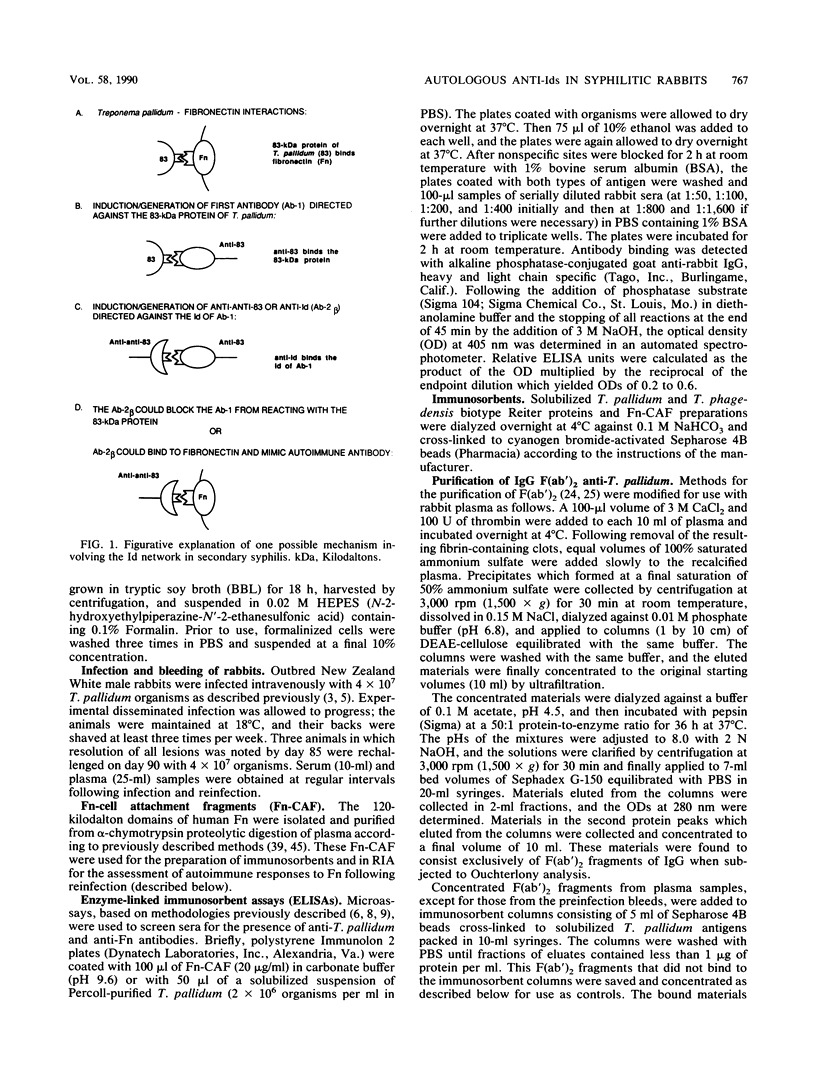
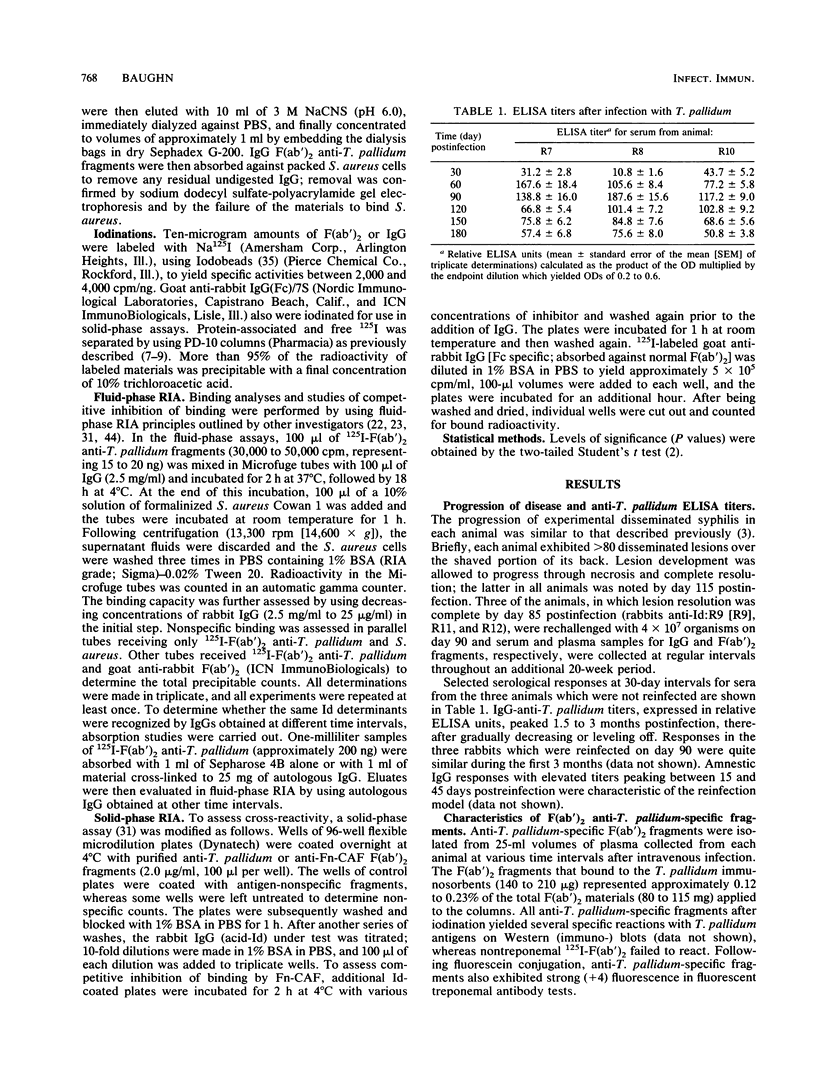
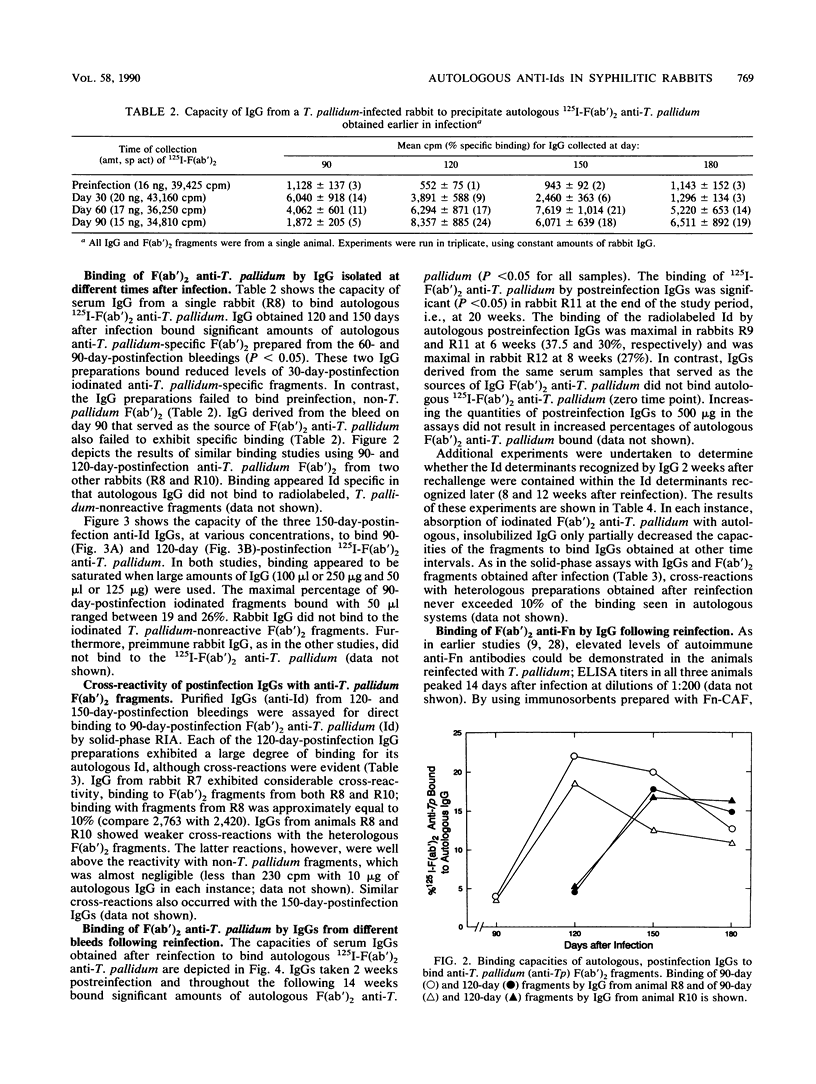
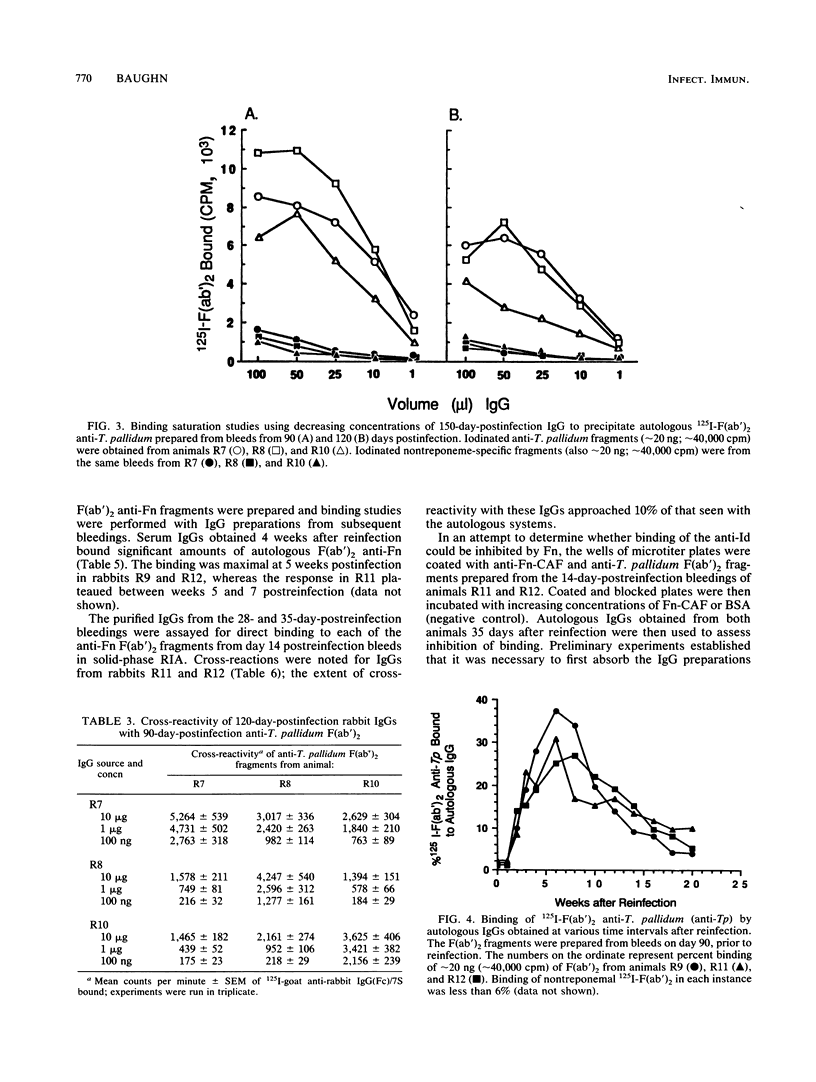
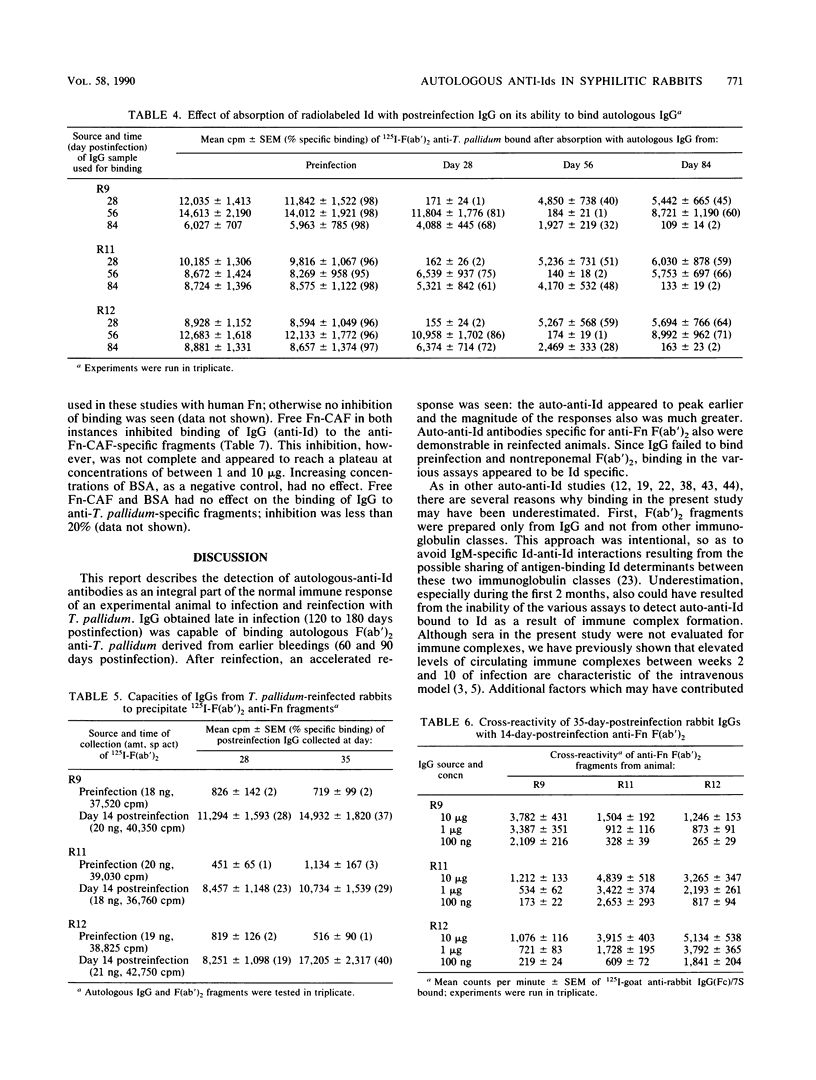
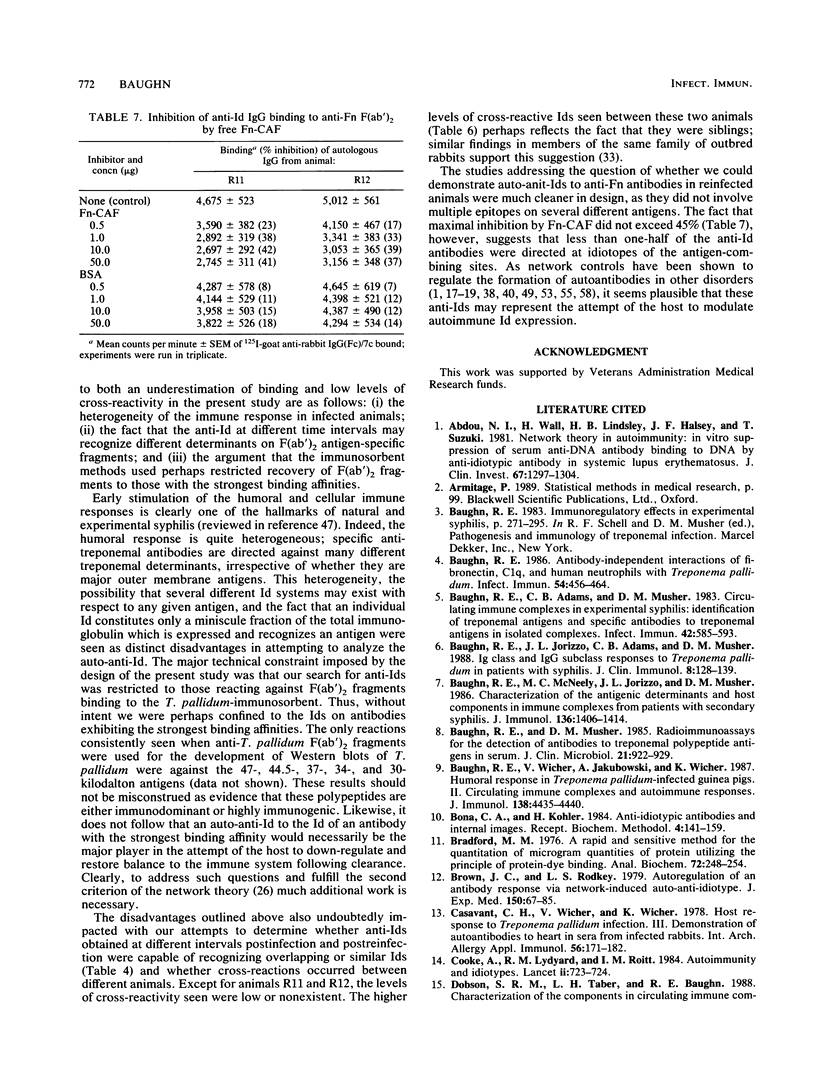
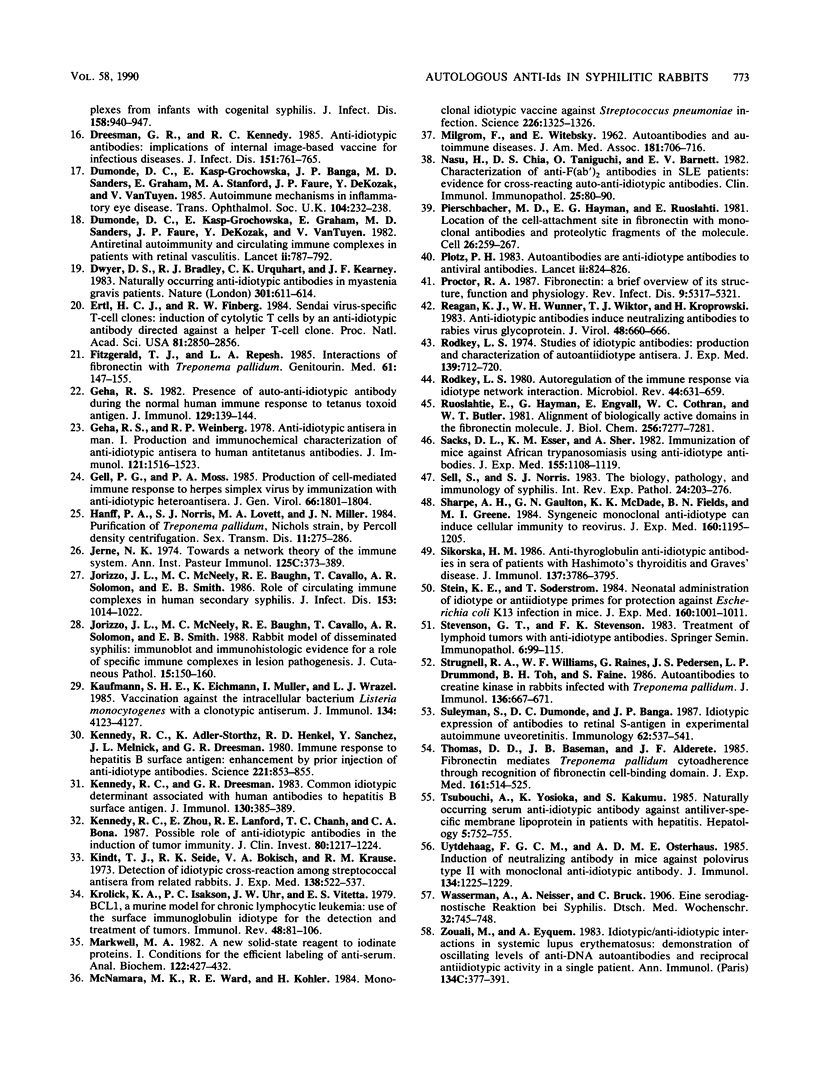
Selected References
These references are in PubMed. This may not be the complete list of references from this article.
- Abdou N. I., Wall H., Lindsley H. B., Halsey J. F., Suzuki T. Network theory in autoimmunity. In vitro suppression of serum anti-DNA antibody binding to DNA by anti-idiotypic antibody in systemic lupus erythematosus. J Clin Invest. 1981 May;67(5):1297–1304. doi: 10.1172/JCI110158. [DOI] [PMC free article] [PubMed] [Google Scholar]
- Baughn R. E., Adams C. B., Musher D. M. Circulating immune complexes in experimental syphilis: identification of treponemal antigens and specific antibodies to treponemal antigens in isolated complexes. Infect Immun. 1983 Nov;42(2):585–593. doi: 10.1128/iai.42.2.585-593.1983. [DOI] [PMC free article] [PubMed] [Google Scholar]
- Baughn R. E. Antibody-independent interactions of fibronectin, C1q, and human neutrophils with Treponema pallidum. Infect Immun. 1986 Nov;54(2):456–464. doi: 10.1128/iai.54.2.456-464.1986. [DOI] [PMC free article] [PubMed] [Google Scholar]
- Baughn R. E., Jorizzo J. L., Adams C. B., Musher D. M. Ig class and IgG subclass responses to Treponema pallidum in patients with syphilis. J Clin Immunol. 1988 Mar;8(2):128–139. doi: 10.1007/BF00917901. [DOI] [PubMed] [Google Scholar]
- Baughn R. E., McNeely M. C., Jorizzo J. L., Musher D. M. Characterization of the antigenic determinants and host components in immune complexes from patients with secondary syphilis. J Immunol. 1986 Feb 15;136(4):1406–1414. [PubMed] [Google Scholar]
- Baughn R. E., Musher D. M. Radioimmunoassays for the detection of antibodies to treponemal polypeptide antigens in serum. J Clin Microbiol. 1985 Jun;21(6):922–929. doi: 10.1128/jcm.21.6.922-929.1985. [DOI] [PMC free article] [PubMed] [Google Scholar]
- Baughn R. E., Wicher V., Jakubowski A., Wicher K. Humoral response in Treponema pallidum-infected guinea pigs. II. Circulating immune complexes and autoimmune responses. J Immunol. 1987 Jun 15;138(12):4435–4440. [PubMed] [Google Scholar]
- Bradford M. M. A rapid and sensitive method for the quantitation of microgram quantities of protein utilizing the principle of protein-dye binding. Anal Biochem. 1976 May 7;72:248–254. doi: 10.1006/abio.1976.9999. [DOI] [PubMed] [Google Scholar]
- Brown J. C., Rodkey L. S. Autoregulation of an antibody response via network-induced auto-anti-idiotype. J Exp Med. 1979 Jul 1;150(1):67–85. doi: 10.1084/jem.150.1.67. [DOI] [PMC free article] [PubMed] [Google Scholar]
- Casavant C. H., Wicher V., Wicher K. Host response to Treponema pallidum infection. III. Demonstration of autoantibodies to heart in sera from infected rabbits. Int Arch Allergy Appl Immunol. 1978;56(2):171–178. [PubMed] [Google Scholar]
- Cooke A., Lydyard P. M., Roitt I. M. Autoimmunity and idiotypes. Lancet. 1984 Sep 29;2(8405):723–725. doi: 10.1016/s0140-6736(84)92628-x. [DOI] [PubMed] [Google Scholar]
- Dobson S. R., Taber L. H., Baughn R. E. Characterization of the components in circulating immune complexes from infants with congenital syphilis. J Infect Dis. 1988 Nov;158(5):940–947. doi: 10.1093/infdis/158.5.940. [DOI] [PubMed] [Google Scholar]
- Dreesman G. R., Kennedy R. C. Anti-idiotypic antibodies: implications of internal image-based vaccines for infectious diseases. J Infect Dis. 1985 May;151(5):761–765. doi: 10.1093/infdis/151.5.761. [DOI] [PubMed] [Google Scholar]
- Dumonde D. C., Kasp-Grochowska E., Banga J. P., Sanders M. D., Graham E., Stanford M. A., Faure J. P., De Kozak Y., Van Tuyen V. Autoimmune mechanisms in inflammatory eye disease. Trans Ophthalmol Soc U K. 1985;104(Pt 3):232–238. [PubMed] [Google Scholar]
- Dumonde D. C., Kasp-Grochowska E., Graham E., Sanders M. D., Faure J. P., de Kozak Y., van Tuyen V. Anti-retinal autoimmunity and circulating immune complexes in patients with retinal vasculitis. Lancet. 1982 Oct 9;2(8302):787–792. doi: 10.1016/s0140-6736(82)92679-4. [DOI] [PubMed] [Google Scholar]
- Dwyer D. S., Bradley R. J., Urquhart C. K., Kearney J. F. Naturally occurring anti-idiotypic antibodies in myasthenia gravis patients. Nature. 1983 Feb 17;301(5901):611–614. doi: 10.1038/301611a0. [DOI] [PubMed] [Google Scholar]
- Ertl H. C., Finberg R. W. Sendai virus-specific T-cell clones: induction of cytolytic T cells by an anti-idiotypic antibody directed against a helper T-cell clone. Proc Natl Acad Sci U S A. 1984 May;81(9):2850–2854. doi: 10.1073/pnas.81.9.2850. [DOI] [PMC free article] [PubMed] [Google Scholar]
- Fitzgerald T. J., Repesh L. A. Interactions of fibronectin with Treponema pallidum. Genitourin Med. 1985 Jun;61(3):147–155. doi: 10.1136/sti.61.3.147. [DOI] [PMC free article] [PubMed] [Google Scholar]
- Geha R. S. Presence of auto-anti-idiotypic antibody during the normal human immune response to tetanus toxoid antigen. J Immunol. 1982 Jul;129(1):139–144. [PubMed] [Google Scholar]
- Geha R. S., Weinberg R. P. Anti-idiotypic antisera in man. I. Production and immunochemical characterization of anti-idiotypic antisera to human antitetanus antibodies. J Immunol. 1978 Oct;121(4):1518–1523. [PubMed] [Google Scholar]
- Gell P. G., Moss P. A. Production of cell-mediated immune response to herpes simplex virus by immunization with anti-idiotypic heteroantisera. J Gen Virol. 1985 Aug;66(Pt 8):1801–1804. doi: 10.1099/0022-1317-66-8-1801. [DOI] [PubMed] [Google Scholar]
- Hanff P. A., Norris S. J., Lovett M. A., Miller J. N. Purification of Treponema pallidum, Nichols strain, by Percoll density gradient centrifugation. Sex Transm Dis. 1984 Oct-Dec;11(4):275–286. doi: 10.1097/00007435-198410000-00003. [DOI] [PubMed] [Google Scholar]
- Jerne N. K. Towards a network theory of the immune system. Ann Immunol (Paris) 1974 Jan;125C(1-2):373–389. [PubMed] [Google Scholar]
- Jorizzo J. L., McNeely M. C., Baughn R. E., Cavallo T., Solomon A. R., Smith E. B. Rabbit model of disseminated syphilis: immunoblot and immunohistologic evidence for a role of specific immune complexes in lesion pathogenesis. J Cutan Pathol. 1988 Jun;15(3):150–160. doi: 10.1111/j.1600-0560.1988.tb00535.x. [DOI] [PubMed] [Google Scholar]
- Jorizzo J. L., McNeely M. C., Baughn R. E., Solomon A. R., Cavallo T., Smith E. B. Role of circulating immune complexes in human secondary syphilis. J Infect Dis. 1986 Jun;153(6):1014–1022. doi: 10.1093/infdis/153.6.1014. [DOI] [PubMed] [Google Scholar]
- Kaufmann S. H., Eichmann K., Müller I., Wrazel L. J. Vaccination against the intracellular bacterium Listeria monocytogenes with a clonotypic antiserum. J Immunol. 1985 Jun;134(6):4123–4127. [PubMed] [Google Scholar]
- Kennedy R. C., Adler-Storthz K., Henkel R. D., Sanchez Y., Melnick J. L., Dreesman G. R. Immune response to hepatitis B surface antigen: enhancement by prior injection of antibodies to the idiotype. Science. 1983 Aug 26;221(4613):853–855. doi: 10.1126/science.6603657. [DOI] [PubMed] [Google Scholar]
- Kennedy R. C., Dreesman G. R. Common idiotypic determinant associated with human antibodies to hepatitis B surface antigen. J Immunol. 1983 Jan;130(1):385–389. [PubMed] [Google Scholar]
- Kennedy R. C., Zhou E. M., Lanford R. E., Chanh T. C., Bona C. A. Possible role of anti-idiotypic antibodies in the induction of tumor immunity. J Clin Invest. 1987 Nov;80(5):1217–1224. doi: 10.1172/JCI113195. [DOI] [PMC free article] [PubMed] [Google Scholar]
- Kindt T. J., Seide R. K., Bokisch V. A., Krause R. M. Detection of idiotypic cross-reactions among streptococcal antisera from related rabbits. J Exp Med. 1973 Sep 1;138(3):522–537. doi: 10.1084/jem.138.3.522. [DOI] [PMC free article] [PubMed] [Google Scholar]
- Krolick K. A., Isakson P. C., Uhr J. W., Vitetta E. S. BCL1, a murine model for chronic lymphocytic leukemia: use of the surface immunoglobulin idiotype for the detection and treatment of tumor. Immunol Rev. 1979;48:81–106. doi: 10.1111/j.1600-065x.1979.tb00299.x. [DOI] [PubMed] [Google Scholar]
- MILGROM F., WITEBSKY E. Autoantibodies and autoimmune diseases. JAMA. 1962 Aug 25;181:706–716. [PubMed] [Google Scholar]
- McNamara M. K., Ward R. E., Kohler H. Monoclonal idiotope vaccine against Streptococcus pneumoniae infection. Science. 1984 Dec 14;226(4680):1325–1326. doi: 10.1126/science.6505692. [DOI] [PubMed] [Google Scholar]
- Nasu H., Chia D. S., Taniguchi O., Barnett E. V. Characterization of anti-F(ab')2 antibodies in SLE patients. Evidence for cross-reacting auto-anti-idiotypic antibodies. Clin Immunol Immunopathol. 1982 Oct;25(1):80–90. doi: 10.1016/0090-1229(82)90167-2. [DOI] [PubMed] [Google Scholar]
- Pierschbacher M. D., Hayman E. G., Ruoslahti E. Location of the cell-attachment site in fibronectin with monoclonal antibodies and proteolytic fragments of the molecule. Cell. 1981 Oct;26(2 Pt 2):259–267. doi: 10.1016/0092-8674(81)90308-1. [DOI] [PubMed] [Google Scholar]
- Plotz P. H. Autoantibodies are anti-idiotype antibodies to antiviral antibodies. Lancet. 1983 Oct 8;2(8354):824–826. doi: 10.1016/s0140-6736(83)90740-7. [DOI] [PubMed] [Google Scholar]
- Reagan K. J., Wunner W. H., Wiktor T. J., Koprowski H. Anti-idiotypic antibodies induce neutralizing antibodies to rabies virus glycoprotein. J Virol. 1983 Dec;48(3):660–666. doi: 10.1128/jvi.48.3.660-666.1983. [DOI] [PMC free article] [PubMed] [Google Scholar]
- Rodkey L. S. Autoregulation of immune responses via idiotype network interactions. Microbiol Rev. 1980 Dec;44(4):631–659. doi: 10.1128/mr.44.4.631-659.1980. [DOI] [PMC free article] [PubMed] [Google Scholar]
- Rodkey L. S. Studies of idiotypic antibodies. Production and characterization of autoantiidiotypic antisera. J Exp Med. 1974 Mar 1;139(3):712–720. doi: 10.1084/jem.139.3.712. [DOI] [PMC free article] [PubMed] [Google Scholar]
- Ruoslahti E., Hayman E. G., Engvall E., Cothran W. C., Butler W. T. Alignment of biologically active domains in the fibronectin molecule. J Biol Chem. 1981 Jul 25;256(14):7277–7281. [PubMed] [Google Scholar]
- Sacks D. L., Esser K. M., Sher A. Immunization of mice against African trypanosomiasis using anti-idiotypic antibodies. J Exp Med. 1982 Apr 1;155(4):1108–1119. doi: 10.1084/jem.155.4.1108. [DOI] [PMC free article] [PubMed] [Google Scholar]
- Sell S., Norris S. J. The biology, pathology, and immunology of syphilis. Int Rev Exp Pathol. 1983;24:203–276. [PubMed] [Google Scholar]
- Sharpe A. H., Gaulton G. N., McDade K. K., Fields B. N., Greene M. I. Syngeneic monoclonal antiidiotype can induce cellular immunity to reovirus. J Exp Med. 1984 Oct 1;160(4):1195–1205. doi: 10.1084/jem.160.4.1195. [DOI] [PMC free article] [PubMed] [Google Scholar]
- Sikorska H. M. Anti-thyroglobulin anti-idiotypic antibodies in sera of patients with Hashimoto's thyroiditis and Graves' disease. J Immunol. 1986 Dec 15;137(12):3786–3795. [PubMed] [Google Scholar]
- Stein K. E., Söderström T. Neonatal administration of idiotype or antiidiotype primes for protection against Escherichia coli K13 infection in mice. J Exp Med. 1984 Oct 1;160(4):1001–1011. doi: 10.1084/jem.160.4.1001. [DOI] [PMC free article] [PubMed] [Google Scholar]
- Stevenson G. T., Stevenson F. K. Treatment of lymphoid tumors with anti-idiotype antibodies. Springer Semin Immunopathol. 1983;6(1):99–115. doi: 10.1007/BF01857369. [DOI] [PubMed] [Google Scholar]
- Strugnell R. A., Williams W. F., Raines G., Pedersen J. S., Drummond L. P., Toh B. H., Faine S. Autoantibodies to creatine kinase in rabbits infected with Treponema pallidum. J Immunol. 1986 Jan;136(2):667–671. [PubMed] [Google Scholar]
- Suleyman S., Dumonde D. C., Banga J. P. Idiotypic expression of antibodies to retinal S-antigen in experimental autoimmune uveoretinitis. Immunology. 1987 Dec;62(4):537–541. [PMC free article] [PubMed] [Google Scholar]
- Thomas D. D., Baseman J. B., Alderete J. F. Fibronectin mediates Treponema pallidum cytadherence through recognition of fibronectin cell-binding domain. J Exp Med. 1985 Mar 1;161(3):514–525. doi: 10.1084/jem.161.3.514. [DOI] [PMC free article] [PubMed] [Google Scholar]
- Tsubouchi A., Yoshioka K., Kakumu S. Naturally occurring serum antiidiotypic antibody against antiliver-specific membrane lipoprotein in patients with hepatitis. Hepatology. 1985 Sep-Oct;5(5):752–757. doi: 10.1002/hep.1840050508. [DOI] [PubMed] [Google Scholar]
- Uytdehaag F. G., Osterhaus A. D. Induction of neutralizing antibody in mice against poliovirus type II with monoclonal anti-idiotypic antibody. J Immunol. 1985 Feb;134(2):1225–1229. [PubMed] [Google Scholar]
- Zouali M., Eyquem A. Idiotypic/antiidiotypic interactions in systemic lupus erythematosus: demonstration of oscillating levels of anti-DNA autoantibodies and reciprocal antiidiotypic activity in a single patient. Ann Immunol (Paris) 1983 May-Jun;134C(3):377–391. [PubMed] [Google Scholar]


